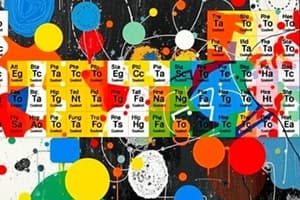Podcast
Questions and Answers
Which of the following properties generally decreases as you move from left to right across a period on the periodic table?
Which of the following properties generally decreases as you move from left to right across a period on the periodic table?
- Electron affinity
- Atomic radius (correct)
- Electronegativity
- Ionization energy
Which of the following best describes the trend for ionization energy as you move down a group on the periodic table?
Which of the following best describes the trend for ionization energy as you move down a group on the periodic table?
- Ionization energy remains constant due to constant number of electrons.
- Ionization energy exhibits no particular pattern.
- Ionization energy generally decreases, due to more electron shielding. (correct)
- Ionization energy generally increases due to increasing nuclear charge.
Which property is most closely associated with an atom's tendency to attract electrons in chemical bonds?
Which property is most closely associated with an atom's tendency to attract electrons in chemical bonds?
- Ionization energy
- Electron affinity
- Electronegativity (correct)
- Atomic radius
How do the chemical properties of lanthanides and actinides differ from those of the main group elements?
How do the chemical properties of lanthanides and actinides differ from those of the main group elements?
Which of the following generally represents the trend for metallic property as you move across a period from left to right?
Which of the following generally represents the trend for metallic property as you move across a period from left to right?
Flashcards
Atomic Radius
Atomic Radius
The size of an atom, often measured as the distance between the nucleus and the outermost electron shell.
Ionization Energy
Ionization Energy
The minimum energy required to remove an electron from a gaseous atom in its ground electronic state.
Electronegativity
Electronegativity
The ability of an atom to attract electrons towards itself when forming a chemical bond.
Electron Affinity
Electron Affinity
Signup and view all the flashcards
Metallic Property
Metallic Property
Signup and view all the flashcards
Study Notes
Trends in the Periodic Table
- The periodic table shows patterns in the chemical behavior of elements.
- Learning targets include predicting element behavior using the periodic table.
- Trends in the periodic table are similar to patterns observed in nature.
- Key trends include atomic radius/size, ionization energy, electronegativity, electron affinity, and metallic property.
Atomic Radius/Size
- Atomic radius is the distance from the atom's nucleus to its outermost electron.
- It's half the distance between the nuclei of two bonded atoms.
- Atomic size increases from right to left across a period and increases from top to bottom within a group.
- Increased nuclear charge pulls the electron cloud closer, decreasing atomic size.
Ionization Energy
- Ionization energy is the energy needed to remove an electron from an atom.
- It's higher for smaller atoms because it is more difficult to remove an electron.
- Ionization energy increases from bottom to top and left to right in the periodic table.
- Shielding effect describes the attraction between an electron and the nucleus in atoms with more than one electron.
Electronegativity
- Electronegativity is the measure of an atom's attraction for another atom's electrons.
- Atoms of some elements may attract valence electrons in a bond more strongly than others.
- Electronegativity increases from bottom to top and left to right.
- Exceptions include noble gases (complete valence shell), lanthanides, and actinides (more complicated chemistry).
Electron Affinity
- Electron affinity is the energy change when an atom gains an electron.
- It generally increases from bottom to top and left to right.
Metallic Property
- Metallic property is how easily atoms lose or gain electrons.
- Metals tend to lose electrons (cations).
- Nonmetals tend to gain electrons (anions).
- Metallic character increases from right to left and top to bottom.
Studying That Suits You
Use AI to generate personalized quizzes and flashcards to suit your learning preferences.




